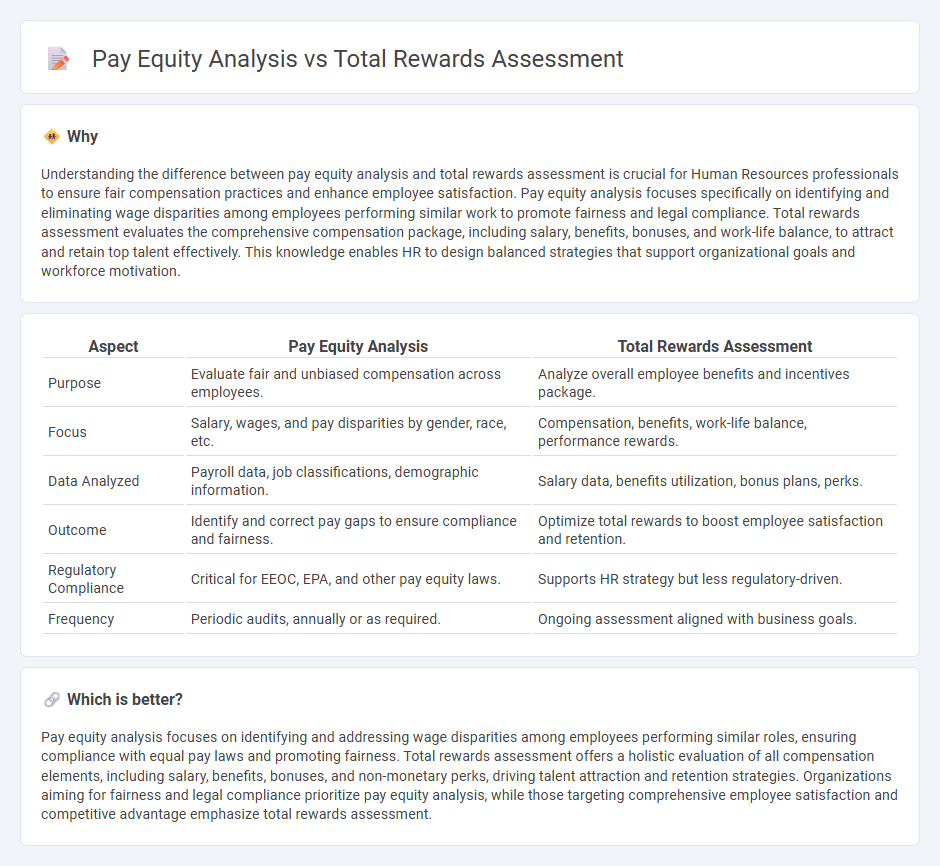
Pay equity analysis evaluates compensation fairness across employees by identifying and addressing wage disparities related to gender, ethnicity, or other protected characteristics. Total rewards assessment examines the broader spectrum of employee benefits, including salary, bonuses, health insurance, retirement plans, and work-life balance initiatives to enhance overall job satisfaction and retention. Explore in-depth strategies and best practices for optimizing workforce compensation and benefits management to foster equity and engagement.
Why it is important
Understanding the difference between pay equity analysis and total rewards assessment is crucial for Human Resources professionals to ensure fair compensation practices and enhance employee satisfaction. Pay equity analysis focuses specifically on identifying and eliminating wage disparities among employees performing similar work to promote fairness and legal compliance. Total rewards assessment evaluates the comprehensive compensation package, including salary, benefits, bonuses, and work-life balance, to attract and retain top talent effectively. This knowledge enables HR to design balanced strategies that support organizational goals and workforce motivation.
Comparison Table
| Aspect | Pay Equity Analysis | Total Rewards Assessment |
|---|---|---|
| Purpose | Evaluate fair and unbiased compensation across employees. | Analyze overall employee benefits and incentives package. |
| Focus | Salary, wages, and pay disparities by gender, race, etc. | Compensation, benefits, work-life balance, performance rewards. |
| Data Analyzed | Payroll data, job classifications, demographic information. | Salary data, benefits utilization, bonus plans, perks. |
| Outcome | Identify and correct pay gaps to ensure compliance and fairness. | Optimize total rewards to boost employee satisfaction and retention. |
| Regulatory Compliance | Critical for EEOC, EPA, and other pay equity laws. | Supports HR strategy but less regulatory-driven. |
| Frequency | Periodic audits, annually or as required. | Ongoing assessment aligned with business goals. |
Which is better?
Pay equity analysis focuses on identifying and addressing wage disparities among employees performing similar roles, ensuring compliance with equal pay laws and promoting fairness. Total rewards assessment offers a holistic evaluation of all compensation elements, including salary, benefits, bonuses, and non-monetary perks, driving talent attraction and retention strategies. Organizations aiming for fairness and legal compliance prioritize pay equity analysis, while those targeting comprehensive employee satisfaction and competitive advantage emphasize total rewards assessment.
Connection
Pay equity analysis identifies discrepancies in employee compensation across different demographics, while total rewards assessment evaluates the entirety of benefits, incentives, and compensation provided by an organization. Integrating pay equity analysis with total rewards assessment ensures fair, competitive, and transparent compensation structures that enhance employee satisfaction and retention. This alignment supports compliance with equal pay regulations and fosters a culture of inclusivity and equity within human resources management.
Key Terms
**Total Rewards Assessment:**
Total Rewards Assessment evaluates comprehensive employee compensation, including salary, benefits, bonuses, and non-monetary perks to enhance workforce motivation and retention. It incorporates market benchmarking and internal equity to ensure competitive and fair reward structures aligned with organizational goals. Discover more about how Total Rewards Assessment drives strategic HR decisions.
Compensation Benchmarking
Total rewards assessment evaluates the comprehensive value employees receive, including salary, benefits, and incentives, ensuring competitive and motivating packages. Pay equity analysis specifically examines compensation fairness across demographics to identify and address wage disparities within the workforce. Discover how combining these approaches enhances compensation benchmarking strategies for equitable and attractive pay structures.
Benefits Utilization
Benefits utilization in total rewards assessment evaluates how effectively employees engage with offered benefits, impacting overall compensation satisfaction and retention rates. Pay equity analysis examines if compensation, including benefits, is distributed fairly across demographics to prevent disparities and ensure compliance with equal pay laws. Discover more about balancing benefits utilization and pay equity to enhance your organization's rewards strategy.
Source and External Links
Compensation Corner: The Total Rewards Strategic Assessment - A Total Rewards Strategic Assessment is an objective analysis that benchmarks critical HR functions--including compensation, benefits, performance management, and employee development--through comprehensive organizational reviews, management interviews, and market assessments to guide confident decision-making in compensation and benefits programs.
What is a Total Rewards Strategy? A Practical Guide - A total rewards strategy is a coordinated business approach that aligns compensation, benefits, wellbeing, development, and recognition to attract, motivate, and retain employees by addressing both their financial and non-financial needs.
What Are Employee Total Rewards and Why Should You Implement Them - Total rewards combine monetary and non-monetary incentives--such as pay, benefits, flexibility, and career growth--and quantifying these can enhance talent attraction, retention, and employee satisfaction by clearly communicating the full value of working for your organization.
 dowidth.com
dowidth.com